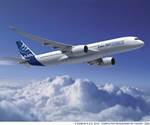Panelized option attested early on
Airbus' (Toulouse, France) use of large composite panels attached to frames in the A350 fuselage — is comparable to the optimal design conclusion reached by the Advanced Technology Composite Aircraft Structures (ATCAS) program back in the late 1990s.
Although it was developed independently by Airbus (Toulouse, France), this approach to constructing the A350 XWB’s fuselage sections — the use of large composite panels attached to frames — is comparable to the optimal design conclusion reached by the Advanced Technology Composite Aircraft Structures (ATCAS) program back in the late 1990s. ATCAS was part of the National Aeronautics and Space Admin.’s (NASA) Advanced Composites Technology (ACT) initiative in the U.S. Under the ACT mandate, the development of an all-composite commercial transport aircraft was split between two parallel programs: McDonnell Douglas Aerospace Co. (Long Beach, Calif.) was tasked with the design and development of a full-scale all-composite wing, and the ATCAS program, conducted by Boeing Commercial Airplanes (Seattle, Wash.), was to do the same for a composite fuselage. According to publicly released reports in 1997 and 1998 by ATCAS’s technical leader Peter Smith and principal investigator/structural engineer Dr. Larry Ilcewicz (currently the Federal Aviation Admin.’s national resource specialist for advanced composite materials) each area of a composite fuselage (crown, sides and keel) presents unique structural design challenges. The crown panel is primarily governed by tension loading, the sides are dominated by shear and pressure load redistribution around windows and doors, and the keel is subject to complex loading dominated by axial compression and load redistribution from the keel beam. The reports also note that the panel-and-frame approach reduces panel assembly costs because it requires fewer longitudinal splices and leverages the size efficiencies of automated fiber placement (AFP) manufacturing while maintaining design flexibility within each uniquely loaded area.
Related Content
-
Manufacturing the MFFD thermoplastic composite fuselage
Demonstrator’s upper, lower shells and assembly prove materials and new processes for lighter, cheaper and more sustainable high-rate future aircraft.
-
The potential for thermoplastic composite nacelles
Collins Aerospace draws on global team, decades of experience to demonstrate large, curved AFP and welded structures for the next generation of aircraft.
-
Welding is not bonding
Discussion of the issues in our understanding of thermoplastic composite welded structures and certification of the latest materials and welding technologies for future airframes.













